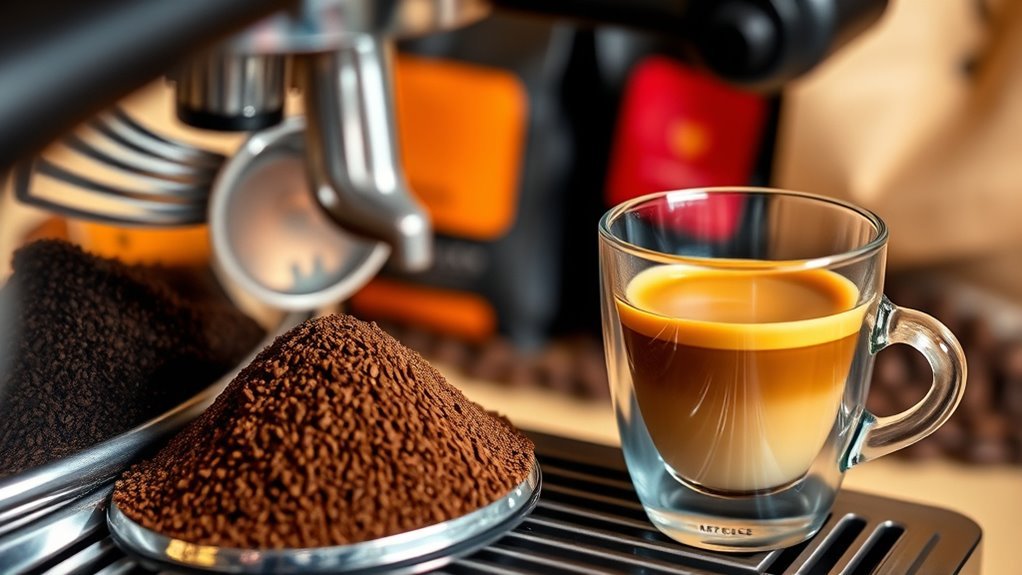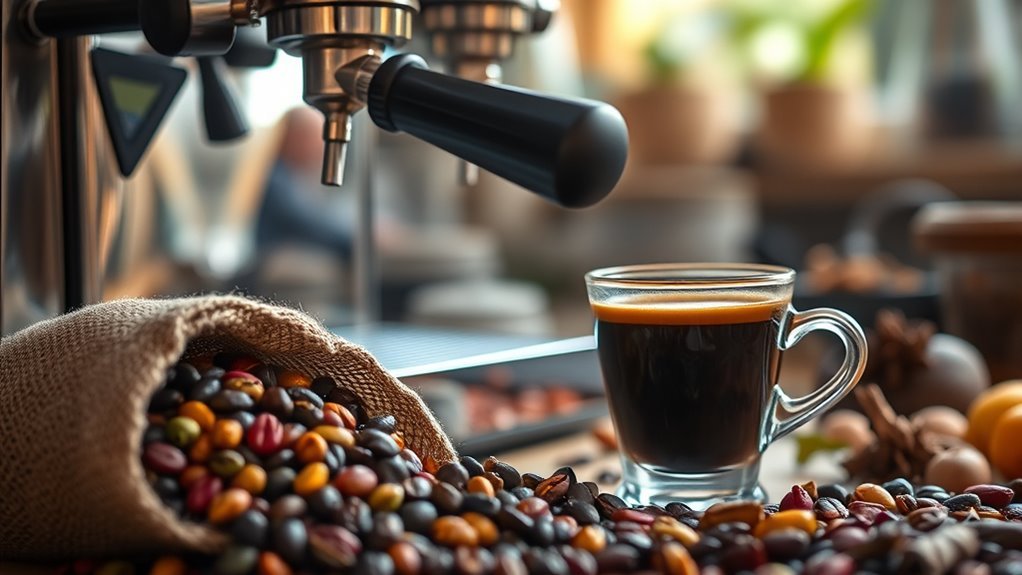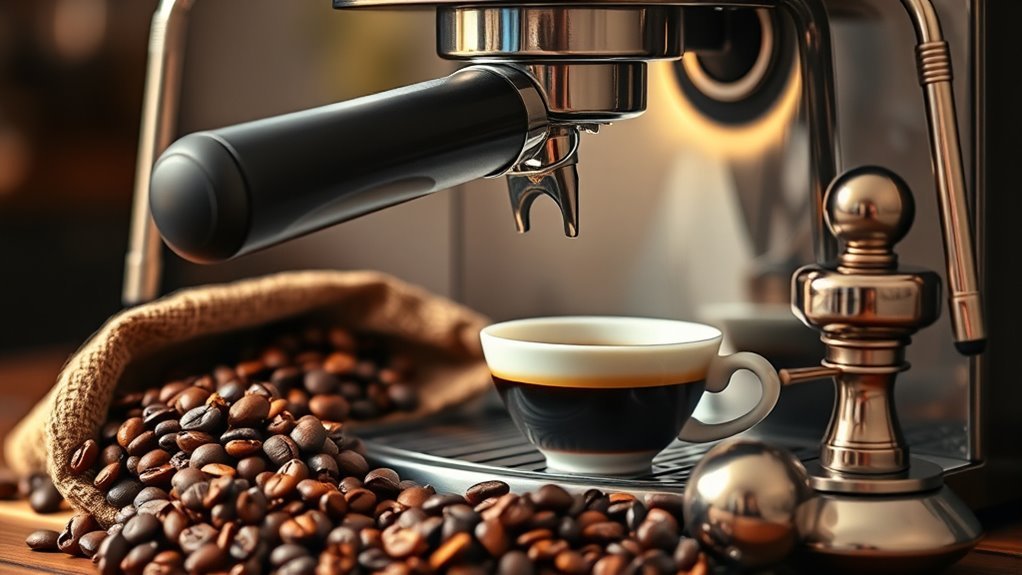Can You Make Espresso With Any Coffee
You can make espresso with various types of coffee, but the quality and flavor will vary considerably based on the specific beans you choose. It’s vital to take into account factors like grind size, roast level, and origin when aiming for the perfect shot. Lighter roasts might yield brighter flavors, while darker ones can create bolder profiles. Adjusting your brewing technique for different beans is essential. Explore further to understand how these elements play a role in enhancing your espresso experience.
Understanding Espresso: The Basics

Espresso, often regarded as the heart of coffee culture, is a concentrated coffee beverage brewed by forcing hot water through finely-ground coffee beans under high pressure. The espresso definition revolves around its unique brewing method, which yields a rich, bold flavor and a creamy texture. Its history dates back to early 20th-century Italy, where it emerged as a quick, invigorating drink for busy urbanites. Understanding espresso means recognizing its significance not just as a beverage, but as a cultural phenomenon that embodies speed and quality. You might find that its preparation requires specific techniques, equipment, and coffee bean selection to achieve that quintessential espresso shot. This knowledge can empower you to appreciate espresso’s depth and versatility in coffee culture.
The Role of Coffee Beans in Espresso
The type of coffee beans you choose greatly impacts your espresso’s flavor profile. Factors like bean origin, roast level, and grind size all play essential roles in determining the extraction quality and taste. Understanding these elements can help you create a more balanced and enjoyable espresso experience.
Bean Origin Matters
While many coffee enthusiasts might believe any coffee can be used for espresso, the origin of the beans considerably influences the flavor, aroma, and overall quality of the final shot. Here’s why bean origin matters:
- Regional Characteristics: Different regions impart unique bean flavors due to varying climates and soil types, leading to distinct taste profiles.
- Processing Methods: How beans are processed post-harvest affects their brewing technique. Some methods enhance sweetness, while others bring out acidity.
- Varietal Differences: The variety of coffee plant influences flavor complexity. Certain beans naturally lend themselves better to espresso than others.
Choosing the right origin is essential for achieving that rich, full-bodied espresso experience you crave. Don’t underestimate the impact of your coffee’s roots!
Roast Level Influence
When selecting coffee for espresso, understanding roast level is vital, as it greatly impacts flavor, aroma, and crema. Different roast levels—light, medium, or dark—each offer unique roast flavors that can either enhance or detract from your espresso experience. For instance, lighter roasts tend to emphasize acidity and fruity notes, while darker roasts provide a bold, rich profile with chocolatey undertones.
Moreover, roast consistency is essential; unevenly roasted beans can lead to an imbalanced extraction, resulting in a less enjoyable cup. To truly appreciate espresso, you’ll want to experiment with various roast levels, discovering how each one affects the overall taste and aroma. Ultimately, understanding these nuances will empower you to make informed choices for a remarkable espresso.
Grind Size Importance
Roast level isn’t the only factor that influences the quality of your espresso; grind size plays a pivotal role as well. Achieving the right grind consistency and texture can make or break your brew. Here are three key aspects to weigh:
- Grind Consistency: Uniform particle size ensures even extraction, preventing bitter or sour notes.
- Grind Texture: Finer grinds increase surface area, allowing for a richer flavor profile but can lead to over-extraction if too fine.
- Brew Time: Different grind sizes affect how quickly water passes through the coffee, impacting strength and flavor.
Arabica vs. Robusta: What’s the Difference?
Understanding the differences between Arabica and Robusta coffee beans is essential for anyone looking to brew the perfect espresso. Arabica beans, known for their smooth, complex flavor, often carry notes of fruit and sugar, making them a favorite among coffee aficionados. In contrast, Robusta beans are prized for their strength, delivering a bold, earthy taste with higher caffeine content. If you’re aiming for a richer crema and a stronger punch in your espresso, blending Robusta with Arabica can enhance both flavor and body. Ultimately, your choice between these two types will influence not just the taste, but also the overall experience of your espresso. So, explore both options to find the balance that suits your palate best.
Factors That Affect Espresso Extraction

Although many factors contribute to espresso extraction, the most critical elements include grind size, water temperature, and brewing time. Understanding these factors can greatly enhance your espresso experience. Here are three key components to take into account:
- Grind Size: A fine grind allows for maximum extraction, while a coarse grind may lead to under-extraction.
- Water Temperature: Ideal temperatures between 190°F and 205°F guarantee proper extraction technique, influencing flavor and aroma.
- Brew Duration: The ideal brew duration typically ranges from 25 to 30 seconds, as this affects the balance of flavors extracted.
Experimenting With Different Coffee Beans
When experimenting with different coffee beans for espresso, the variety of the bean greatly impacts flavor profiles and extraction characteristics. You’ll also need to take into account the roast level, as lighter roasts tend to produce brighter flavors, while darker roasts offer bolder, more robust profiles. Adjusting these variables can lead to a unique espresso experience tailored to your taste preferences.
Bean Variety Impact
Many coffee enthusiasts underestimate the impact of bean variety on espresso quality. The unique bean characteristics of different coffee varieties can greatly influence your espresso’s flavor profiles. Here are three key factors to evaluate:
- Origin: Beans from different regions offer distinct taste notes; for instance, Ethiopian beans often have fruity and floral flavors, while Brazilian beans can be nutty and chocolatey.
- Processing Method: The way beans are processed affects their acidity and sweetness. Natural processing usually results in a fruitier profile, whereas washed beans tend to be cleaner and brighter.
- Varietal Differences: Arabica and Robusta beans each bring unique flavors; Arabica typically offers a smoother taste, while Robusta can add boldness and crema.
Experimenting with these varieties can elevate your espresso experience.
Roast Level Considerations
The roast level of coffee beans plays a significant role in shaping the final espresso’s flavor profile. When you experiment with different roast profiles, you’ll notice a wide array of flavor notes that can transform your espresso experience. Light roasts often bring out bright acidity and fruity flavors, while medium roasts strike a balance between sweetness and complexity. Dark roasts, on the other hand, tend to emphasize bold, smoky tones and diminished acidity. By understanding these nuances, you can tailor your espresso to suit your taste preferences. So, don’t hesitate to explore various roast levels; the freedom to choose different beans allows you to discover unique combinations that elevate your espresso game.
Tips for Brewing With Non-Traditional Beans

Although traditional espresso is typically made from specific coffee beans, experimenting with non-traditional varieties can yield surprisingly delightful results if approached with care. To make the most of your brewing experience, consider these tips:
- Adjust Brewing Techniques: Different beans may require unique brewing methods. Experiment with grind size and extraction time to find the right balance.
- Explore Flavor Profiles: Non-traditional beans offer diverse flavor notes. Taste as you brew to discover and enhance these unique characteristics.
- Monitor Temperature and Pressure: These variables can greatly impact the outcome. Keep an eye on your espresso machine settings to guarantee ideal extraction.
Achieving the Perfect Espresso Shot
How can you guarantee that every espresso shot you make is consistently rich and flavorful? Mastering espresso techniques is essential for achieving the perfect flavor balance. Here are some key factors to take into account:
| Factor | Importance |
|---|---|
| Grind Size | Affects extraction rate |
| Dose | Impacts strength and richness |
| Brew Time | Influences flavor development |
| Water Temperature | Affects solubility and taste |
Frequently Asked Questions
Can Espresso Be Made With Pre-Ground Coffee?
Yes, you can make espresso with pre-ground coffee, but the quality matters. The grind size and freshness are vital for ideal extraction. Pre-ground coffee often lacks the freshness necessary for a rich flavor, so you might not achieve the best results. The brewing method also influences the outcome; a fine grind is essential for espresso. If you’re using pre-ground coffee, make sure it’s high quality to enjoy a satisfying cup.
Is Dark Roast Better for Espresso Than Light Roast?
When deciding if dark roast is better for espresso than light roast, consider dark roast advantages. Dark roasts provide deeper, bolder flavor profiles with rich, chocolatey notes that many espresso lovers appreciate. The roasting process enhances oils and sugars, creating a fuller-bodied shot. However, light roasts offer bright acidity and nuanced flavors. Ultimately, it’s about personal preference; experiment with both to discover which aligns with your taste. You might be surprised by the results!
How Fine Should the Coffee Grind Be for Espresso?
When you’re brewing espresso, the grind consistency is essential; it should be very fine, resembling table salt. If you’re tempted to use a coarser grind, remember that it can lead to uneven extraction, resulting in a sour or weak shot. For ideal extraction time, aim for around 25-30 seconds. Finer grounds increase surface area, allowing water to extract flavors efficiently, giving you that rich, full-bodied espresso you crave.
Can Flavored Coffee Beans Be Used for Espresso?
Yes, you can use flavored coffee beans for espresso. However, it’s important to contemplate how the added flavors will impact the taste profile of your shot. Flavored beans often have oils that can affect extraction, potentially leading to over-extraction or a bitter taste. If you enjoy experimenting, try different flavored beans to see how they change your espresso. Just remember, balance is key to achieving the best flavor experience.
Does the Espresso Machine Type Affect the Coffee Choice?
Did you know that around 60% of espresso enthusiasts believe machine type greatly influences flavor? When it comes to coffee machine compatibility, your choice can impact the espresso extraction techniques you use. For instance, a high-end machine may require a finer grind, while a simpler model might work better with coarser beans. Ultimately, selecting the right coffee for your machine can elevate your espresso experience, allowing for richer flavors and smoother shots.






